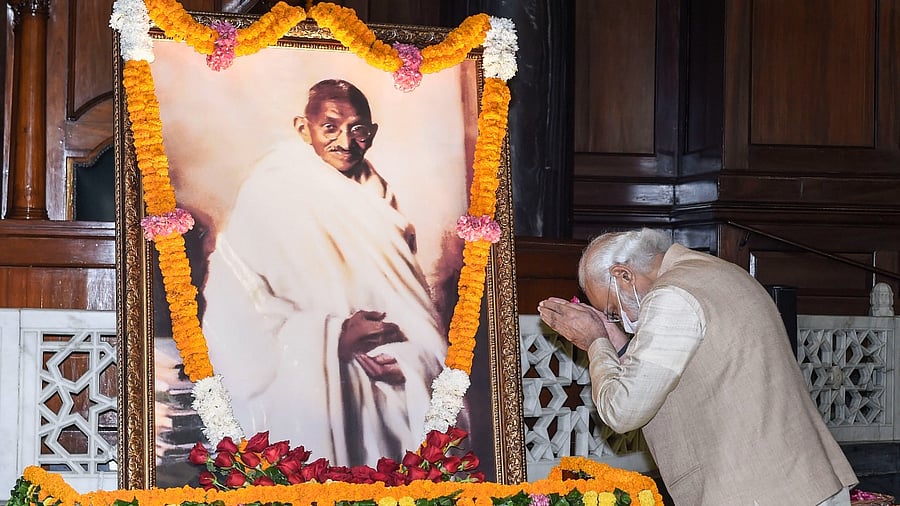
On the eve of Gandhi Jayanti, Prime Minister Narendra Modi alluded to the “glory” of khadi in the 81st edition of Mann ki Baat. He urged citizens to adopt and promote khadi as a tribute to Mahatma Gandhi who relentlessly promoted khadi as a symbol of an Atma Nirbhar Bharat. The Modi government has championed khadi by initiating several schemes to improve artisans’ welfare and add value to the khadi segment. But is all well in the khadi sector as indicated by the rise in sales?
Not really. Khadi rose to popularity as the freedom fabric during India’s struggle for Independence. Gandhiji pegged the values of self-reliance and rural empowerment with this humble cloth. To uphold this legacy, the government institutionalised the khadi and Village Industries Commission (KVIC) and charged it with the planning, promotion, organisation and implementation of programmes for the development of khadi and other village industries in the rural areas.
Cut to 75 years after Independence, the khadi of today has deviated from both the philosophy and the fabric that Gandhi wove in his era. The KVIC has trademarked the word ‘khadi’. The proprietorship of ‘khadi’ has put KVIC in a disproportionately powerful position. Over the years, the body has served legal notices to more than 1,000 firms alleging them of producing and affixing the word “khadi” to their fabric.
Khadi, by definition, is a handspun and handwoven cloth. The hand spinning and weaving, which is integral to the identity of khadi, is very limited in practice today. With the semi-mechanised Amber charkhas, New Model Charkhas (NMC) and solar charkhas that involve little to no human intervention, the hand rendered characteristic of khadi has eroded.
The market is presently dominated by KVIC-certified Khadi Institutions(KIs)[3] that use mechanised charkhas in spinning khadi. This has come at the expense of khadi’s authenticity and uniqueness lent to it by the spinner’s skill. Consequently, the market is monopolised by this “fast” khadi as opposed to the traditional handspun khadi which requires intricate skilled work. This also acts as a deterrent for other firms to pursue traditional means of khadi production. This abstruse understanding of khadi based on laws and KVIC’s direction hamper consumer and seller aspirations. There is a need to categorise khadi based on the production technique involved to create more transparency for consumers. At the same time, it will encourage producers to manufacture traditional khadi and get the correct value for their products.
Incentive mechanisms
Government funds are directed to KIs for various schemes such as ‘interest subsidy eligibility certificate (ISEC)’, Modified Market Development Assistance (MMDA), Aam Admi Bima Yojana for Khadi artisans, publicity and marketing support etc. The combined effect of incentive mechanisms rendered to KIs distort the market and put other businesses at a disadvantage, effectively killing healthy competition. As such, private businesses do not have incentive to go through an intensive process to obtain the khadi mark label without which no textile can be sold or traded in the country.
Despite the financial support to KIs, artisans’ interests are not safeguarded. In the current milieu, artisans earn paltry wages for their work. With an average daily wage between Rs 150 and 200, khadi spinners, who make up almost 80% of all khadi artisans, are severely underpaid. This is less than the minimum wages prescribed by the government for other jobs involving unskilled work. In many states, minimum wages for unskilled workers under the National Rural Guarantee Employment Scheme goes as high as Rs 300. Due to this, the youth are not zealous about learning the art of khadi spinning.
The institutional set-up in the khadi sector is also rigid where the entire process from procurement, production, sales and distribution are dictated by KVIC. Today, an artisan producing a handspun and handwoven cloth may not be able to transact as he may not own the khadi mark label nor be able to navigate the cumbersome process.
Such an artisan may not possess the financial means to secure the khadi mark in the first place. This framework that restricts the economic freedom of weavers/producers conflicts with the ethos of Gandhi. So the question stands, can one say khadi is for all in today’s India as was envisioned when KVIC was instituted?
The time is ripe for the rise of khadi. The government’s call for an Atma Nirbhar Bharat is resonating with consumer sentiments, as more citizens seek indigenous products. There is tremendous scope of employment generation by initiating favourable policies that allow more participants in producing and selling khadi. To be true to the spirit of Gandhi’s movement, khadi needs to be revived as a symbol of India’s liberal values that empowers artisans, accommodates aspiring businesses, and encourages sustainable lifestyle on a wider scale.
(Borawake is Associate and Solomon is Senior Associate, Research, Centre for Public Policy Research)